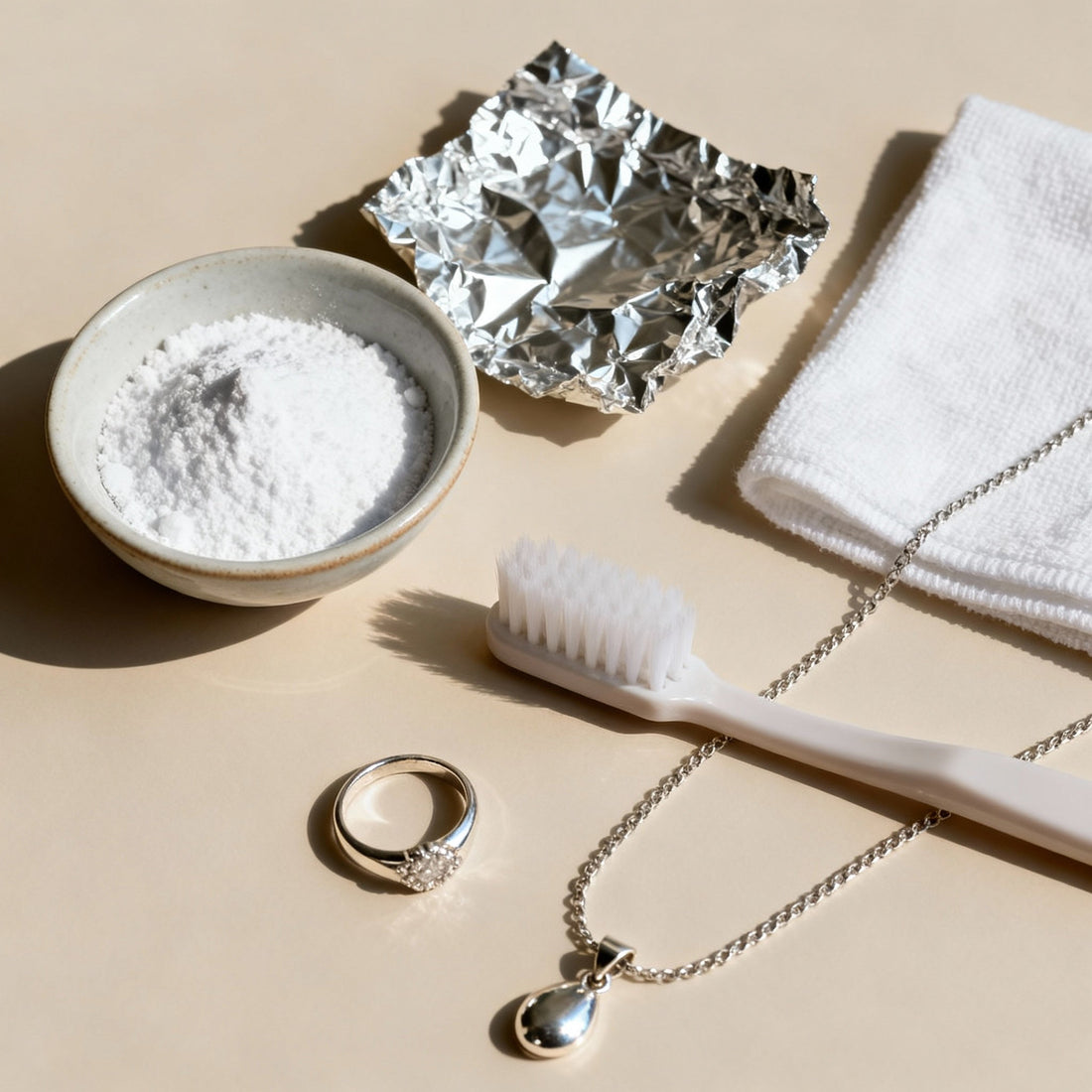
Silver Cleaning at Home: The Ultimate Guide to Restoring Your Jewellery's Shine
Silver cleaning at home has never been easier or more affordable. With simple household items from your kitchen cupboard, you can restore your tarnished sterling silver jewellery to its original brilliance without expensive commercial cleaners or professional services.
Why Clean Silver at Home?
Home silver cleaning offers numerous advantages over commercial alternatives :
-
Cost-effective: Uses common household items
-
Environmentally friendly: Reduces chemical waste
-
Convenient: Clean anytime without leaving home
-
Gentle: Natural methods are often safer for delicate pieces
-
Immediate results: No waiting for appointments
Essential Items for Silver Cleaning at Home
Before starting your silver cleaning project, gather these common household items :
Basic Supplies
-
Aluminium foil
-
Bicarbonate of soda (baking soda)
-
White vinegar
-
Lemon juice
-
Soft-bristled toothbrush
-
Microfibre cloths
-
Lukewarm water
Optional Items
-
Non-gel toothpaste
-
Washing-up liquid
-
Hand sanitiser
-
Lemon-lime fizzy drinks
The Top 5 Silver Cleaning Methods at Home
1. The Aluminium Foil and Bicarbonate of Soda Method
This is the most effective home method for heavily tarnished silver :
What You Need:
-
Large bowl
-
Aluminium foil
-
1-2 tablespoons bicarbonate of soda
-
Boiling water
Steps:
-
Line bowl with foil, shiny side facing up
-
Place tarnished silver on the foil
-
Sprinkle bicarbonate of soda over pieces
-
Pour boiling water to cover completely
-
Leave for 10-30 minutes depending on tarnish severity
-
Remove and buff dry with soft cloth
How It Works: The chemical reaction between aluminium and bicarbonate of soda creates a gentle electrolytic process that removes tarnish without scrubbing.
2. Bicarbonate of Soda Paste Method
Perfect for targeted cleaning of specific tarnished areas :
What You Need:
-
3 parts bicarbonate of soda
-
1 part lukewarm water
-
Soft cloth or sponge
Steps:
-
Mix into a thick paste consistency
-
Apply to tarnished areas using circular motions
-
Work gently with soft cloth
-
Rinse thoroughly with lukewarm water
-
Dry immediately and buff to shine
3. White Vinegar and Bicarbonate of Soda Solution
Excellent for moderately tarnished pieces :
What You Need:
-
1/2 cup white vinegar
-
2 tablespoons bicarbonate of soda
-
Soft cloth
Steps:
-
Soak silver in vinegar for 2 hours
-
Create bicarbonate of soda paste
-
Scrub gently with the paste
-
Rinse and dry thoroughly
4. Toothpaste Method (Light Tarnish Only)
Ideal for quick touch-ups on lightly tarnished pieces :
Requirements:
-
Non-gel, non-whitening toothpaste
-
Soft-bristled toothbrush
-
Lukewarm water
Process:
-
Apply small amount of toothpaste
-
Gently brush in circular motions
-
Focus on tarnished areas only
-
Rinse thoroughly
-
Dry and polish with soft cloth
5. Lemon Juice and Salt Method
Natural acidic cleaning for stubborn tarnish :
Ingredients:
-
Fresh lemon juice
-
Table salt
-
Soft cloth
Method:
-
Mix lemon juice with pinch of salt
-
Apply to tarnished areas
-
Leave for 5-10 minutes
-
Rub gently with cloth
-
Rinse and dry completely
What NOT to Use When Cleaning Silver at Home
Avoid these common household items that can damage silver :
Harmful Products
-
Bleach: Causes permanent damage
-
Ammonia-based cleaners: Too harsh for silver
-
Abrasive materials: Steel wool, scouring pads
-
Gel toothpastes: Contains abrasives
-
Paper towels: Can scratch the surface
Unsuitable Methods
-
Dishwasher cleaning: Heat can damage settings
-
Harsh scrubbing: Removes silver plating
-
Soaking gemstone pieces: Can loosen settings
Special Considerations for Different Silver Items
Sterling Silver Jewellery
-
Chains and bracelets: Use soft brush for intricate links
-
Rings with settings: Avoid soaking methods
-
Earrings: Clean posts separately from decorative elements
Silver-Plated Items
-
Gentler approach required: Plating is thin and easily damaged
-
Shorter exposure times: Limit contact with cleaning solutions
-
Professional assessment: Consider professional cleaning for valuable pieces
Silver Cleaning Safety Tips
Follow these essential safety guidelines :
Before Cleaning
-
Remove all jewellery before handling chemicals
-
Work in well-ventilated area
-
Test methods on inconspicuous areas first
-
Check for loose stones or damaged settings
During Cleaning
-
Wear gloves when using acidic solutions
-
Never mix different cleaning chemicals
-
Use lukewarm water only (hot water can damage some stones)
-
Work over padded surfaces to prevent dropping
After Cleaning
-
Rinse thoroughly to remove all cleaning residue
-
Dry immediately to prevent water spots
-
Store properly to prevent future tarnishing
How Often Should You Clean Silver at Home?
Regular maintenance schedules help prevent heavy tarnishing :
-
Daily wear pieces: Clean monthly
-
Occasional wear items: Clean every 3-6 months
-
Storage pieces: Inspect and clean annually
-
Emergency cleaning: When tarnish becomes noticeable
Maintaining Silver After Home Cleaning
Proper post-cleaning care extends time between cleanings :
Immediate Steps
-
Dry completely before storage
-
Polish with dedicated silver cloth
-
Apply thin coat of clear nail varnish to prevent tarnishing (optional)
Long-term Storage
-
Store in anti-tarnish pouches
-
Include chalk or charcoal packets to absorb moisture
-
Keep pieces separated to prevent scratching
-
Avoid plastic bags (can trap moisture)
When to Seek Professional Help
While home cleaning works excellently for most situations, consider professional services for :
-
Antique or valuable pieces
-
Complex settings with multiple gemstones
-
Severely damaged items
-
Pieces with sentimental value
Cost Comparison: Home vs Professional Silver Cleaning
-
Bicarbonate of soda: £1-2 for multiple cleanings
-
Household items: Already available in most homes
-
Professional cleaning: £5-15 per piece
-
Annual savings: £50-200 depending on collection size
Troubleshooting Common Silver Cleaning Problems
Problem: White Residue After Cleaning
Solution: Inadequate rinsing - rewash with plain water and dry thoroughly
Problem: Scratches Appearing
Solution: Too much pressure or wrong materials - use gentler methods and softer cloths
Problem: Tarnish Returns Quickly
Solution: Improper storage or incomplete cleaning - ensure thorough drying and proper storage
Environmental Benefits of Home Silver Cleaning
Eco-friendly advantages of home methods :
-
Reduces packaging waste from commercial cleaners
-
Uses biodegradable household ingredients
-
Eliminates transport emissions from professional services
-
Decreases chemical runoff into water systems
The Science Behind Home Silver Cleaning
Understanding why these methods work helps you choose the right approach :
-
Bicarbonate of soda: Alkaline properties neutralise acidic tarnish
-
Aluminium foil reaction: Creates electrochemical process that reverses tarnishing
-
Acidic solutions: Break down silver sulphide compounds
-
Gentle abrasives: Physically remove tarnish layer
Conclusion: Mastering Silver Cleaning at Home
Silver cleaning at home is not only possible but preferable for most sterling silver jewellery maintenance. With the right techniques and household ingredients, you can achieve professional-quality results whilst saving money and protecting the environment. Regular home cleaning keeps your silver pieces looking their absolute best, ensuring they remain beautiful for generations to come.
The key to successful home silver cleaning lies in choosing the appropriate method for your specific pieces, following safety guidelines, and maintaining proper storage afterwards. With these comprehensive techniques at your disposal, your silver jewellery will continue to sparkle and shine for years to come.
